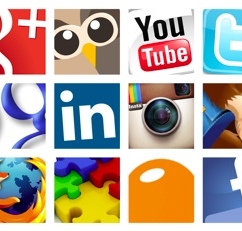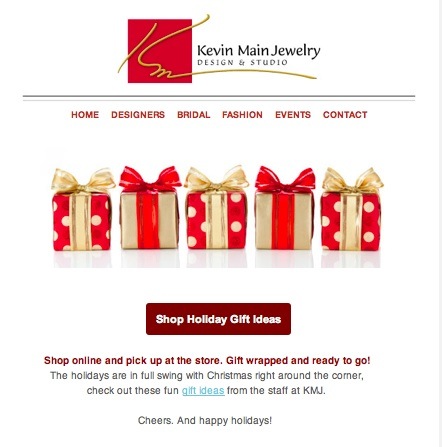Articles and News
How To Get Your Message Ahead Of The Curve in 2014 | December 18, 2013 (0 comments)

Atlanta, GA—Geo-locators. Social sharing. Responsive design. Browser abandonment. When it comes to digital marketing, things change so fast that luxury retailers barely have time to understand what their customers respond to before “the next big thing” is being pushed at them. When today’s next big thing quickly becomes yesterday’s has-been, what digital marketing strategies really are worth a luxury jeweler’s time and investment?
The Centurion Newsletter asked Laurie Hood, vice president of product marketing for Silverpop Systems Inc., a digital marketing firm specializing in automated digital marketing software and systems. Hood recently presented a webinar titled “What To Expect in 2014 And How To Stay Ahead Of The Curve.” In this exclusive interview with The Centurion, she identifies the key digital marketing developments that matter most to luxury jewelers.
The Centurion Newsletter: In the webinar, you discussed analyzing web user behavior to see where they go. How easy is it for an independent retailer to do?
Laurie Hood: Analyzing web behavior involves putting some kind of tracking code on their website. Jewelers have probably worked with some kind of third party to develop their website, so start there. Putting tracking code is not complicated or complex, but if you’re going to track the behavior, what are you going to do with the behavior?
Centurion: What would they do with it?
Hood: With the high purchase dollars of luxury jewelry, you could look at it almost in a B2B way and put it into a CRM (customer relationship management) system, or put it into a tool like Silverpop to send targeted emails based on their behavior or other data.
You’re somewhat relying on a degree of loyalty that says “they’re absolutely going to call me when they decide to buy a Rolex or strand of Mikimoto pearls,” but the digital side helps you react if they come to your website as a way of reaching out, or by uncovering an undiscovered need [based on their behavior on your site.] And as you start to appeal to a younger demographic, the digital expectation is there.
Centurion: What digital data is most actionable for an independent luxury jeweler? Most know their customers well already, but is there anything that only data can tell?
Hood: In a long-term relationship, people’s tastes change, so [digital web] data can show shifts in what people are interested in. And it’s about opening doors to the next generation. As we become much more of a global economy, a lot more people are less hesitant about buying an expensive piece of jewelry online, having it shipped, and if they don’t like it, shipping it back. I don’t want to get someone on the phone to talk to me about something that I may not be able to afford, but giving me the opportunity to communicate with you online is a perfect opportunity for me to get to know you and for you to capture information—a spouse’s birthday or anniversary, etc.
The ability to get that is just an opportunity to expand business, and it’s not a huge investment. You may have multigenerational relationships with your customers but don’t assume you will have the same relationship with the younger generation. I’m sure they have a lot of loyalty but in a global economy customers can find out where to buy something anywhere.

Laurie Hood, vice president of product marketing, Silverpop Systems Inc.
Centurion: Three big topics in digital marketing now are cart abandonment and browser abandonment programs, and responsive design. Do these matter if a jeweler isn’t e-commerce enabled?
Hood: Yes. There are different levels of digital marketing to consider:
- Even if you don’t do ecommerce, you need a good website that showcases your business and gives customers something good to look at. And do you have a good permission-based email program in place to communicate with your customers?
- The next level is e-commerce.
- The next level is getting customer data on primary buying opportunities (important dates, wishlists, etc.) and sending communication around that. Are you maximizing your opportunities?
- Consider participating as a vendor on a site such as FirstDibs. For example, I’ve bought on FirstDibs, and I had good experiences buying directly from its vendors, and I always let them know how I found them. Sites like that are vetted so that could be a good place to expand your reach.
- Finally, have some kind of email program that is triggered by behavior or triggered by piece of data, but you definitely want it automated, so that at night the program wakes up and says “whose birthday is next month?” and sends an email 30 days out and another 15 days out, and so forth.

This email from Kevin Main Jewelers offers an instantaneous and compelling call to action for its "brick and click" model blending e-commerce with in-store service.
Centurion: Most jewelers probably already have lists of customer birthdays, anniversaries, engaged couples, etc., and send out mailings on their own now. Why would they pay for a program that does the same thing?
Hood: It’s all in what you want to invest. If I pay someone to create an automated program that remembers important customer dates and tracks behavior, it saves me or my sales staff a lot of time every month to do it manually. People who shop at a luxury store want high-touch, so jewelers probably send handwritten notes, but this also means you can have email air cover as well as the handwritten notes. It’s hard to stay top of mind in crowded environment, but there ways to set up email so it doesn’t look like it came from an automated program. It can be highly personalized.
Centurion: What about free email services like Constant Contact, VerticalResponse, or Mailchimp?
Hood: You may not get as much data from the free automated services [as a customized one], but my guess is that even those have a lot more tools than most people use. So if jewelers get a consultant who is well versed in them they could find a lot more they can do. You can even call Constant Contact or Mailchimp and see if they have a consultant network and can recommend one.
Centurion: If a jeweler is already doing an email newsletter, what’s the next step? And what should they look for if they are going to buy a third party program?
Hood: Look for someone that has a lot of competency in whatever technology they’re using. And in this case, look for someone that has some experience with specialty retailers. It doesn’t necessarily have to be higher end retail, but definitely specialty retailers, because that experience will transfer. Again, get referrals from friends or vendors or start by asking your web people.
Another thing to do is look at other companies they admire, either local or regional or even national, and see what they’re doing. Look for peer brands that sell to same market. Sign up for Tiffany’s email. Go to Lexus or Mercedes and sign up for their programs. Burberry is super-aggressive in use of technology. That’s the cool thing about digital—you can find out a lot about what other people are doing, because it’s just out there.
Centurion: What will a browser-abandonment program do and what actions should jewelers follow up with?
Hood: [In an automated program] look for integration between website and email. Have something that will tell you where people went on the site and where they jumped off the site. Then follow up on the areas they did click on, such as engagement rings, and end them a series of emails on related topics like the Four C’s, styles, etc.
Centurion: Let’s talk about responsive design. Is it critical for a business that isn’t e-commerce enabled?
Hood: You probably can get away without it, but I’d look into some kind of design detail that will make sure your email doesn’t look bad on a mobile device. Opening email is the number-one phone activity.
You’re going to start selling to a market where going online is second nature. Prospects are 50%-70% into the buying cycle before they contact the vendor, and with a younger audience you’re looking at people who want to do that research online. They’re far more likely to do that than the senior executive who will call you and say “I want something for my wife for Christmas, please pick something she’ll like, wrap it up, and send it to the house.” A younger demographic probably will ask advice from friends on social media about their wife’s present, so how do you tap into that?
Centurion: Not all responsive-design programs work on all devices. If a jeweler is going to shop for one, what should they prioritize?
Hood: Responsive design is actually a coding technique. You would need a third-party provider. If you’re already running an e-commerce site you probably already have a provider, so start there, but responsive design needs someone with specialized coding skills or who will build you a template that is responsive. You’d get someone to build you that template.
From device standpoint, there probably are some industry statistics about device popularity, but I’m not sure. A tool like Litmus can help you understand what devices your readers are using, but if you have an affluent audience, I would look at tablet usage. And they probably have more than one device: a phone and a tablet and a laptop.
When you go to the younger boundary of this [affluent] market, it’s not 18. High school and college kids have different usage patterns than that 35 to 45-year old. You’re talking about people who have jobs and sit in front of a computer. They’re stabilized from their first job and first having kids, they’re heading toward a more significant anniversary or birthday, and may feel it’s time for the nice watch or the nice pearls or the replacement engagement ring. That’s the group jewelers need to hook so they can maintain. But if you also want to start going younger for the future, you need to start investing in this because it’s going to be expected by that demographic.
Centurion: You are a jewelry-lover yourself. Can you offer advice from your own personal perspective?
Hood: I think executive women are an untapped market. Part of it is life stage related; when does disposable income free up, and when you’re young, are you sure that piece is what you really want to invest in? But I think there probably is a huge market of executive women who can buy for themselves but don’t have time to shop. If you get in front of them with email marketing or a good e-commerce site, you’ve changed the game for yourself. Or if she does still want to send a link to her husband with a gift idea, if you can’t get her that link she can’t send it to her husband!
Top image: Studiorui.com







